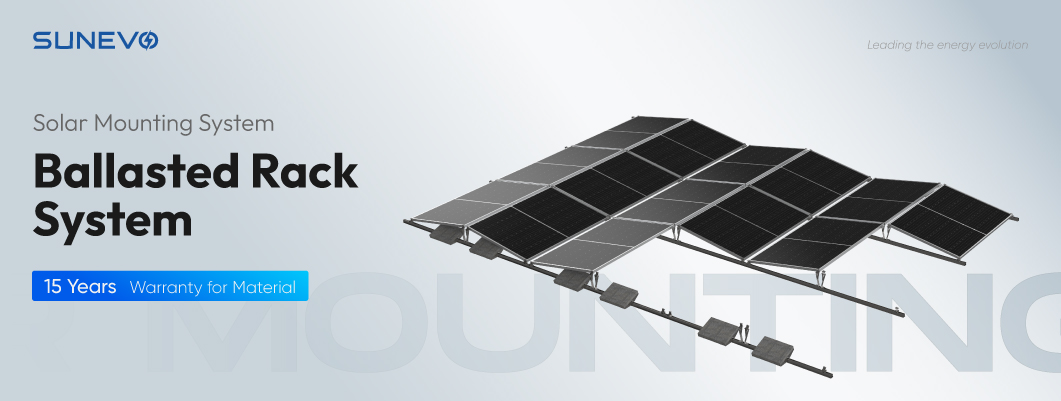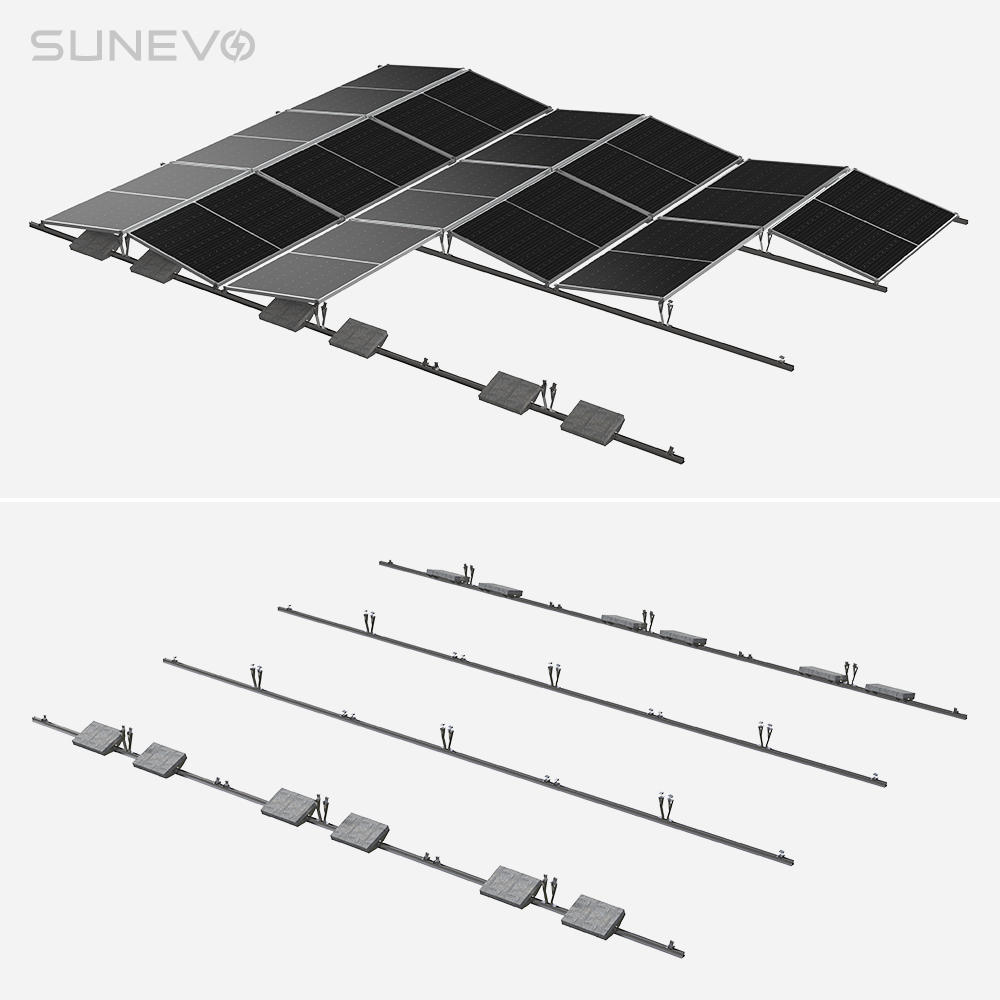Ballasted mounting system is a type of solar panel mounting structure that uses weight to secure the solar panels in place, rather than penetrating the roof surface.
Brand:
SunEvoInstallation Application:
Ballasted Roof Rack SystemPV Module Layout:
LandscapeWind Load:
44m/s or CustomizedSnow Load:
1.6KN/m2 or CustomizedInclination:
Parallel to the roofSunevo Solar Panel Ballasted Mount Bracket Flat Roof Mounting Structure Systems
Ballasted mounting system is a type of solar panel mounting structure that uses weight to secure the solar panels in place, rather than penetrating the roof surface.

Technical Features of Ballasted Mounting Systems:
| Product name | MRac Ballasted Mounting System |
| Installation Site |
Flat/slope roof, Flat ground, Membrane roof |
| Roof Type |
Flat concrete roof, Slope concrete roof, Membrane roof |
| Tilt Angle |
Max 15° |
| Wind Load |
<44m/s |
| Snow Load |
1.6KN/㎡ |
| Applicable Solar Module |
Framed |
| Panel Layout |
Landscape |
| Material | AL6005-T5,SUS 304, EPDM |
| Finish | SUS304 &Zinc-Nickel Alloy Electroplated Steel |
| Module orientation | Landscape |

The components of ballasted roof solar panel mounting brackets typically include:
--Concrete Blocks: These heavy blocks serve as the primary source of weight required to keep the solar panels grounded.
--Ballast Brackets: These brackets provide stability and help distribute the weight evenly on the system.
--Rails: The rails are mounted on the brackets and provide the framework for attaching the solar panels.
--Clamps: These are used to secure the PV panels onto the rails.
--Grounding Equipment: Grounding components such as cables, lugs, and connectors are also included to ensure proper electrical grounding.

The Advantages of Ballasted Roof Mounting Systems
Here are some advantages of Ballasted Mounting systems:
--No roof penetration: Unlike rooftop solar installations, Ballasted Mounting systems are installed directly on the ground, eliminating the need for any roof penetrations. This makes them suitable for a variety of locations, including roofs with strict construction regulations or those with limited load-bearing capacity.
--Easy installation: Ballasted Mounting systems are relatively straightforward to install. They typically use pre-fabricated support structures and ballast blocks or concrete pavers to provide stability. The installation process involves assembling the support structure, placing the required ballast, and mounting the solar panels, making it quicker and simpler compared to other installation methods.
--Flexibility and adjustability: The Ballasted Mounting system allows for flexibility in panel orientation and tilt angle. This flexibility enables optimal solar panel positioning to maximize energy generation based on the specific site characteristics and sun's movement throughout the day. The adjustability also allows for easier maintenance and cleaning of panels.
--Scalability: Ground-mounted ballasted systems can accommodate a larger number of solar panels compared to rooftop installations, making them suitable for commercial and utility-scale solar projects. The ability to scale up the system makes it advantageous for meeting higher energy demands or when space constraints on rooftops are an issue.
--Versatility: Ballasted Mounting systems can be customized to fit various types of terrain and landscapes. They can be installed on open fields, gravel surfaces, or even hilly terrains. With proper engineering and design, the system can adapt to different ground conditions, including uneven or sloped surfaces.
--Reduced maintenance costs: Due to their accessibility and ease of maintenance, ground-mounted ballasted systems typically have lower maintenance costs compared to rooftop installations. Cleaning, inspection, and repair tasks can be performed more efficiently and safely due to unhindered access to the panels.

Package of Rack Mounting
Box or Crate Packaging: The individual packaged components are placed in suitable boxes or crates for consolidation and transportation. These boxes or crates are designed to withstand the rigors of shipping and handling, providing secure and organized packaging.
